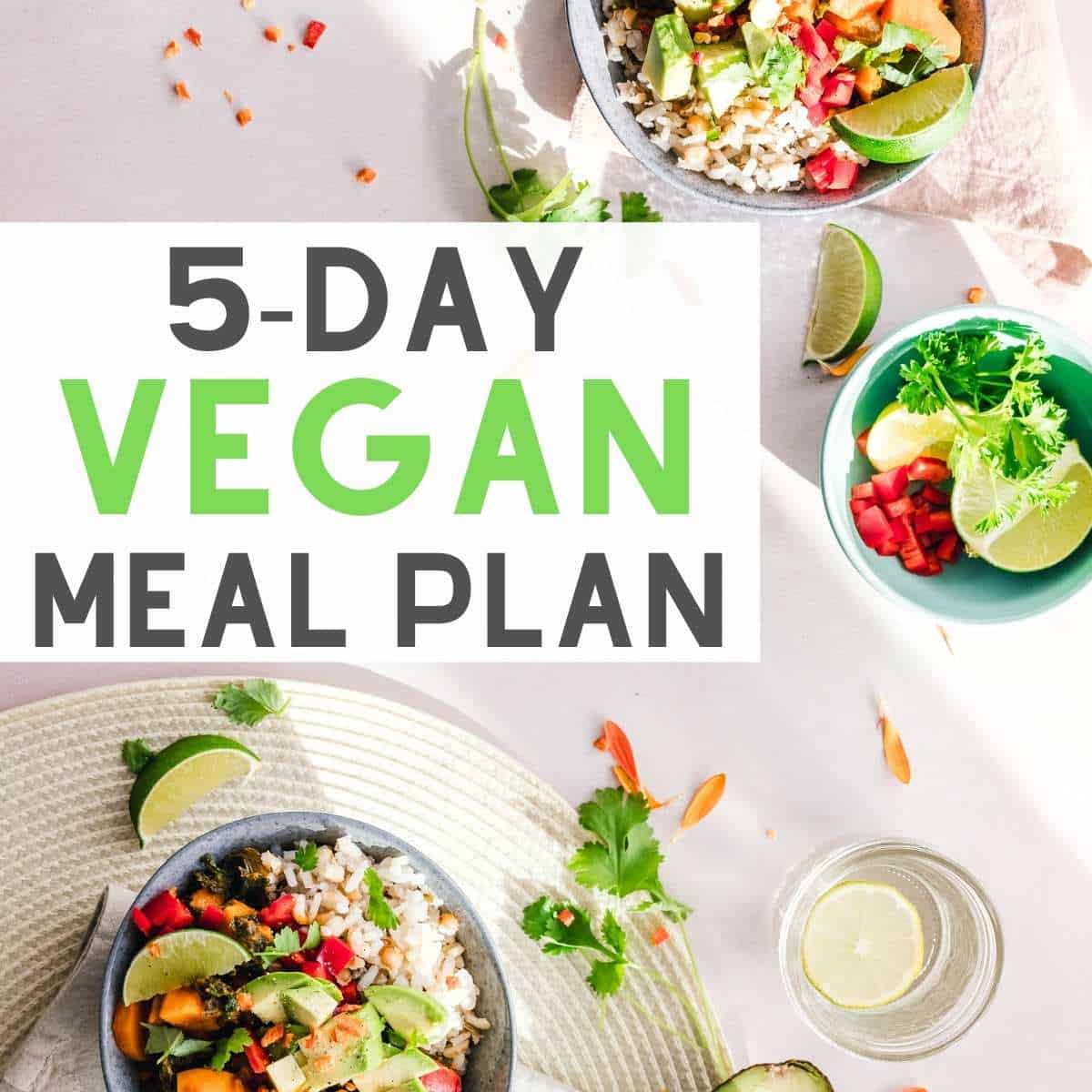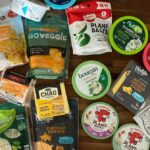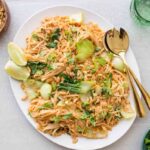Embark on a culinary adventure with this comprehensive guide to crafting a delicious and nutritious weekly vegan meal plan. We’ll journey through the process, from initial planning and recipe selection to mastering meal prep and storage techniques. Discover how to adapt existing recipes, explore diverse cuisines, and address specific dietary needs, all while embracing the vibrant world of plant-based eating.
Learn to navigate the exciting landscape of vegan cooking, transforming everyday meals into flavorful and satisfying experiences. This guide provides a practical framework, empowering you to create a personalized meal plan that aligns with your preferences, dietary needs, and busy lifestyle. Get ready to unlock a world of culinary possibilities!
Planning Your Weekly Vegan Meal Plan

Crafting a delicious and nutritious weekly vegan meal plan requires careful consideration of diverse flavors, nutritional balance, and efficient grocery shopping. A well-structured plan ensures you enjoy a variety of plant-based meals while minimizing food waste and maximizing your time. This section will guide you through the process of creating your own personalized vegan meal plan, complete with a sample plan and a detailed grocery list.
A Sample Weekly Vegan Meal Plan
This sample meal plan showcases a vibrant range of cuisines and incorporates a variety of fruits, vegetables, legumes, and whole grains for optimal nutritional intake. Remember to adjust portion sizes to fit your individual needs and caloric goals.
| Day | Breakfast | Lunch | Dinner |
|---|---|---|---|
| Monday | Overnight Oats with Berries and Nuts | Mediterranean Quinoa Salad with Chickpeas and Feta (vegan feta) | Lentil Shepherd’s Pie with Sweet Potato Topping |
| Tuesday | Tofu Scramble with Spinach and Mushrooms | Black Bean Burgers on Whole Wheat Buns with Avocado | Thai Green Curry with Tofu and Vegetables |
| Wednesday | Smoothie with Banana, Spinach, and Almond Milk | Leftover Thai Green Curry | Vegan Chili with Cornbread |
| Thursday | Vegan Pancakes with Maple Syrup and Fruit | Large Salad with Roasted Vegetables and a Lemon Vinaigrette | Pasta with Marinara Sauce and Vegan Sausage |
| Friday | Avocado Toast with Everything Bagel Seasoning | Leftover Pasta with Marinara Sauce and Vegan Sausage | Pizza with Vegan Cheese and Vegetables |
| Saturday | Breakfast Burrito with Tofu Scramble and Black Beans | Buddha Bowl with Brown Rice, Roasted Sweet Potatoes, and Edamame | Vegan Lasagna |
| Sunday | Vegan Waffles with Berries and Coconut Whipped Cream | Leftover Vegan Lasagna | Vegetable Stir-fry with Brown Rice |
A Detailed Grocery List Based on the Sample Meal Plan
Creating a comprehensive grocery list, categorized by store section, streamlines your shopping experience and minimizes the chance of forgetting essential ingredients. This list corresponds to the sample meal plan above.
Produce Section: Berries, banana, spinach, mushrooms, avocado, sweet potatoes, corn, vegetables for stir-fry (e.g., broccoli, carrots, peppers), onions, garlic, tomatoes, lemon, salad greens.
Dry Goods/Pantry: Oats, quinoa, lentils, black beans, whole wheat buns, brown rice, pasta, marinara sauce, vegan sausage, vegan cheese, pancake mix, waffle mix, maple syrup, nuts, seeds, everything bagel seasoning, spices (curry powder, chili powder, etc.).
Refrigerated Section: Tofu, vegan feta, almond milk, coconut whipped cream.
Frozen Section: (Optional) Pre-cut vegetables for convenience.
Recipe Selection and Adaptation
Crafting a vibrant and nutritious vegan weekly meal plan requires careful consideration of recipe selection and adaptation. A diverse range of recipes ensures you’re getting a wide array of vitamins, minerals, and other essential nutrients, while adapting existing recipes opens up a world of culinary possibilities. This section will explore both aspects, providing practical guidance and delicious examples.
Five Vegan Recipes for a Balanced Weekly Meal Plan
The following recipes offer a diverse range of flavors and nutritional profiles, ensuring a satisfying and healthy vegan week. Each recipe is designed to be relatively easy to prepare, making meal planning less daunting.
- Lentil Shepherd’s Pie: This hearty and comforting dish features a flavorful lentil base topped with creamy mashed sweet potatoes. The lentils provide protein and fiber, while the sweet potatoes offer vitamin A and potassium. Imagine the rich, earthy aroma of the lentils mingling with the subtly sweet scent of the roasted sweet potatoes, creating a dish both visually appealing and deeply satisfying. The vibrant orange of the sweet potato topping contrasts beautifully with the deep brown of the lentil filling.
- Black Bean Burgers: These flavorful burgers are packed with protein and fiber, making them a perfect substitute for traditional beef burgers. Black beans are an excellent source of iron and folate. Picture juicy, flavorful patties sizzling on the grill, their slightly smoky aroma filling the air. The texture is hearty and satisfying, with a slightly crumbly interior giving way to a satisfying chew.
- Vegan Chili: A warming and robust chili brimming with beans, vegetables, and spices. This dish is rich in fiber, antioxidants, and various vitamins and minerals depending on the vegetables used. Visualize a vibrant red chili, simmering gently on the stove, its aroma a rich tapestry of spices and simmering vegetables. Each spoonful reveals a medley of textures and flavors, from the soft beans to the slightly crisp vegetables.
- Quinoa Salad with Roasted Vegetables: A light and refreshing salad packed with protein and fiber. Quinoa provides complete protein, while roasted vegetables offer a variety of vitamins and minerals. Imagine a colorful array of roasted vegetables—peppers, zucchini, onions—tossed with fluffy quinoa and a zesty lemon vinaigrette. The vibrant colors and textures combine to create a visually stunning and incredibly healthy salad.
- Vegan Pad Thai: This flavorful stir-fry features rice noodles, tofu, vegetables, and a tangy peanut sauce. Tofu provides protein, while the vegetables contribute essential vitamins and minerals. Picture a vibrant plate of Pad Thai, the noodles glistening with a rich peanut sauce, surrounded by colorful vegetables and soft tofu. The aroma is fragrant and enticing, a blend of sweet, savory, and spicy notes.
Adapting Existing Non-Vegan Recipes to Vegan Versions
Many traditional recipes can be easily adapted to become vegan-friendly with simple ingredient substitutions. The key is understanding the role of each ingredient and finding suitable replacements.
For example, eggs can often be replaced with flax eggs (1 tablespoon ground flaxseed meal mixed with 3 tablespoons water), applesauce, or mashed banana. Dairy products can be substituted with plant-based milks (soy, almond, oat, etc.), vegan yogurt, or tofu. Butter can be replaced with vegan butter or oil. Meat can be replaced with various plant-based proteins like tofu, tempeh, seitan, lentils, beans, or mushrooms.
When adapting recipes, it’s important to consider the texture and flavor of the original recipe and choose substitutions that will maintain or enhance these qualities. For instance, when substituting ground beef in a chili, lentils or mushrooms provide a similar hearty texture, while walnuts or pecans can add a satisfying richness. Experimentation is key; don’t be afraid to try different substitutions until you find what works best for you.
Nutritional Benefits of the Selected Recipes
Each recipe contributes to a well-rounded and nutritious vegan diet. The lentil shepherd’s pie is a great source of plant-based protein and fiber, while the black bean burgers provide iron and folate. The vegan chili is rich in antioxidants and fiber, while the quinoa salad offers complete protein and various vitamins and minerals from the roasted vegetables. Finally, the vegan Pad Thai delivers protein from tofu and a range of nutrients from the vegetables. By incorporating these recipes into your weekly meal plan, you can ensure you’re getting a diverse array of essential nutrients.
Step-by-Step Recipe Creation & Formatting
Creating a vegan meal plan involves not only selecting recipes but also understanding how to clearly present them. A well-formatted recipe is crucial for ease of use and consistency in your meal planning. This section will detail the process of creating a step-by-step recipe and formatting it for optimal readability. We will use a vibrant and flavorful One-Pan Roasted Vegetables with Lemon-Tahini Dressing as our example.
One-Pan Roasted Vegetables with Lemon-Tahini Dressing: Step-by-Step Preparation
This section provides a detailed, step-by-step guide to preparing our example recipe. Following these steps will ensure a consistently delicious result. Each step is designed to be clear and easy to follow, even for novice cooks.
- Preparation (15 minutes): Preheat your oven to 400°F (200°C). Wash and chop the vegetables. We’re using a medley of colorful vegetables: broccoli florets, bell peppers (red and yellow, chopped into bite-sized pieces), red onion (thinly sliced), and zucchini (cubed). Imagine the vibrant hues of the vegetables contrasting beautifully on the baking sheet.
- Mixing (5 minutes): In a large bowl, toss the chopped vegetables with 2 tablespoons of olive oil, salt, pepper, and a sprinkle of garlic powder. Picture the vegetables glistening with olive oil, ready to roast to perfection. The aroma of garlic will already be tantalizing.
- Roasting (30 minutes): Spread the vegetables in a single layer on a large baking sheet. Roast for 30 minutes, or until tender and slightly caramelized. Envision the vegetables transforming in the oven, their colors deepening, and their edges becoming slightly browned and crispy.
- Dressing Preparation (5 minutes): While the vegetables are roasting, prepare the lemon-tahini dressing. In a small bowl, whisk together ¼ cup tahini, 2 tablespoons lemon juice, 1 tablespoon water, 1 tablespoon olive oil, and a pinch of salt. The creamy tahini combines with the bright lemon juice to create a smooth and tangy dressing.
- Serving (5 minutes): Once the vegetables are roasted, drizzle the lemon-tahini dressing over them and toss gently to coat. Serve immediately. Imagine the glistening vegetables, beautifully coated in the creamy, lemony dressing, ready to be enjoyed.
Recipe Card: One-Pan Roasted Vegetables with Lemon-Tahini Dressing
Yields: 4 servings
Prep time: 15 minutes
Cook time: 30 minutes
Ingredients:
- 1 head broccoli, cut into florets
- 1 red bell pepper, chopped
- 1 yellow bell pepper, chopped
- 1 red onion, thinly sliced
- 2 zucchini, cubed
- 2 tablespoons olive oil
- Salt and pepper to taste
- 1 teaspoon garlic powder
- For the dressing:
- ¼ cup tahini
- 2 tablespoons lemon juice
- 1 tablespoon water
- 1 tablespoon olive oil
- Pinch of salt
Instructions:
- Preheat oven to 400°F (200°C).
- Toss vegetables with olive oil, salt, pepper, and garlic powder.
- Roast for 30 minutes, or until tender and slightly caramelized.
- While vegetables roast, whisk together dressing ingredients.
- Drizzle dressing over roasted vegetables and toss to coat.
- Serve immediately.
Serving Suggestions: Serve as a side dish with roasted chickpeas or tofu, or enjoy as a light and healthy main course. The vibrant colors and flavors make it a perfect addition to any meal.
Cooking Time and Preparation Time Calculation
Accurate calculation of cooking and preparation times is essential for effective meal planning. For our recipe, preparation time includes washing, chopping, and mixing ingredients (15 minutes + 5 minutes = 20 minutes). Cooking time is solely the oven roasting time (30 minutes). The total time investment for this recipe is 50 minutes, a manageable timeframe for a weeknight meal. This calculation method can be applied to all recipes, ensuring realistic time estimations for meal preparation.
Creating a weekly vegan meal plan doesn’t have to be daunting. With careful planning, creative recipe adaptation, and efficient meal prep strategies, you can enjoy a diverse and satisfying plant-based diet. This guide has equipped you with the tools and knowledge to embark on this exciting culinary journey, transforming your relationship with food and fostering a healthier, more sustainable lifestyle. So, dive in, experiment, and savor the delicious results!
Commonly Asked Questions
How do I ensure I get enough protein on a vegan diet?
Focus on incorporating a variety of protein sources like legumes (beans, lentils), tofu, tempeh, seitan, edamame, nuts, seeds, and quinoa. A balanced meal plan will naturally provide sufficient protein.
What are some good vegan substitutes for common non-vegan ingredients?
Many substitutes exist! For example, use plant-based milk instead of dairy milk, tofu or tempeh for meat, flax eggs for chicken eggs, and nutritional yeast for cheese flavor.
How can I make my vegan meal plan more affordable?
Prioritize inexpensive staples like beans, lentils, rice, and seasonal vegetables. Plan your meals around sales and utilize leftovers creatively. Bulk buying can also help reduce costs.
What if I don’t like certain vegetables?
A vegan diet offers incredible variety! Don’t be afraid to experiment with different vegetables and find ones you enjoy. Focus on incorporating a wide range of colors and textures for optimal nutrition.


